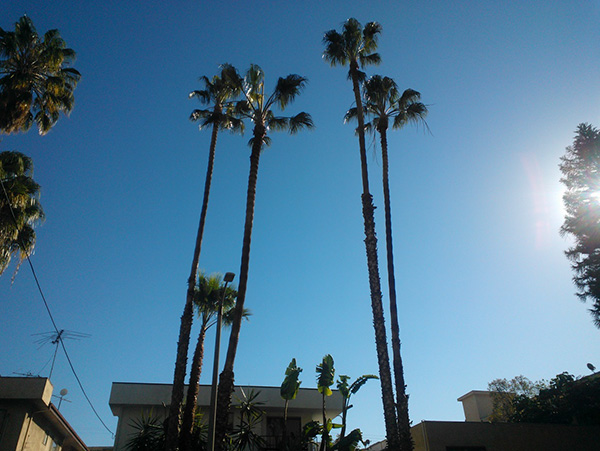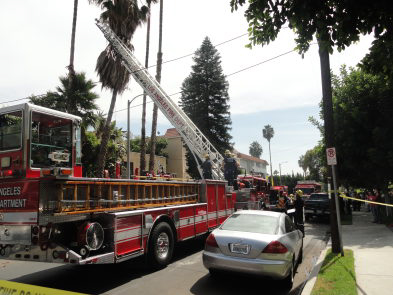Case Report: 12CA011
Tree trimmer dies from asphyxia when compressed by palm fronds
Download a PDF to print this report:
Tree trimmer dies from asphyxia when compressed by palm fronds (12CA011, PDF)
Summary
A tree trimmer died while trimming the fronds from a palm tree in front of an apartment building. The victim climbed up the tree and underneath the dead palm fronds. He cut the dead fronds with a chain saw and then starting pulling on the fronds that were stuck. The frond skirt fell on the victim pressing him against the tree trunk and suffocating him. The victim was not a certified tree worker, nor was he supervised by one. The CA/FACE investigator determined that, in order to prevent future incidents, tree trimming companies and self-employed tree trimmers who trim or remove palm trees should ensure that:
- Palm tree trimming or removal is performed or supervised by workers trained and certified by organizations such as the Tree Care Industry Association (TCIA) or the International Society of Arboriculture (ISA).
- Proper work procedures and equipment are used.
In addition, property owners who need palm trees trimmed or removed should:
- Hire only tree trimmers who are trained or certified by organizations such as the TCIA or ISA.
Introduction
On Saturday, September 22, 2012, at approximately 12:30 p.m., a 27-year-old Hispanic male tree trimmer was asphyxiated after he was compressed by the palm fronds he was trimming from a palm tree. The CA/FACE investigator received notification of this incident on September 28, 2012, from the Los Angeles District Office of the Division of Occupational Safety and Health (Cal/OSHA). On October 24, 2012, the CA/FACE investigator contacted the employer. On November 12, 2012, the incident site was visited, pictures of the tree were obtained, and the employer was interviewed. Subsequent meetings with the employer and workers at the incident site were held to discuss preliminary findings and recommendations. The police and coroner's reports were also obtained.
Employer
The employer of the victim was a tree service company that provided tree trimming, pruning, removal, and other landscaping services. The company had been in business for 19 years and had three employees. The owner was a licensed contractor and had previously been a certified tree trimmer.
Written Safety Programs and Training
The tree service company did not have a written injury or illness prevention program (IIPP) or any formal training in palm tree trimming. According to the victim's father, his son never had any formal training and had learned the trade mostly by on-the-job experience.
Worker Information
The victim was a 27-year-old Hispanic male tree trimmer who was born in Guatemala and had been in the United States for the past five years. He had a high school education and only spoke Spanish. He had approximately four years of experience as a tree trimmer. He was not a certified tree worker.
Incident Scene
The incident scene was a residential street lined with apartment buildings in a suburb of Los Angeles that had numerous palm trees (Exhibit 1).
Weather
The weather on the day of the incident was clear with a mild southwesterly wind and a temperature of 78 to 82 degrees.
Investigation
The company was hired to trim four palm trees in front of an apartment building. The duration of the job was one day. On the day of the incident, the work crew at the job site consisted of the company owner, the victim, the victim's father, and another coworker. The victim was assigned to climb the palm trees and cut off the dead palm fronds. The victim's father and a co-worker were assigned to pick up the fronds on the ground and load them on a truck. The victim wore a climbing harness with a flip line, a tool belt, and shoe gaffs. The first tree was trimmed without incident, and then the company owner left the job site to tend to other business. The victim climbed the second tree and reached the bottom of the dead fronds approximately 30 feet up. He climbed under the fronds and secured himself to the tree with the flip line attached to his harness. He then took the chain saw (attached to his tool belt) and started cutting the dead fronds off the tree. Some of the cut dead fronds did not fall to the ground but instead formed a skirt around the tree. He was pulling on the stuck fronds when suddenly the weight of the skirt caused it to shift on the tree and it slid down the tree onto him. The victim's father asked a passerby to call 911 and he grabbed a ladder and tried to reach his son but the ladder was too short. The co-worker was yelling at the victim, trying to get a response, but there was none. The police and fire department responded and reached the victim within 19 minutes after arrival. He was pronounced dead at the scene.
Cause of Death
The cause of death according to the death certificate was traumatic asphyxia.
Recommendations
In order to prevent future incidents, tree trimming companies and self-employed tree trimmers who trim or remove palm trees should ensure that:
Recommendation #1: Palm tree trimming or removal is performed or supervised by workers trained and certified by organizations such as the TCIA or the ISA.
Discussion: In this incident, the company owner was not a certified tree worker and was not on the job site when the incident occurred. The victim had approximately four years of experience in tree trimming and may have been familiar with general safety procedures. However, according to the victim's father, this experience did not include knowledge about the best methods for trimming palm trees. The TCIA and ISA are two organizations that certify tree trimmers in all aspects of job safety, including the best methods for trimming palm trees. All TCIA and ISA-certified tree workers must attend formal training and pass a knowledge and skills exam conducted by trained evaluators. If the victim had received certification or was supervised by someone who was certified, he or the supervisor may have had the knowledge to recognize the hazards and perform the job in a safe manner, possibly preventing this fatality.
Recommendation #2: Proper work procedures and equipment are used.
Discussion: Safe methods for trimming palm trees include using a bucket truck or aerial device equipped with fall protection. When the use of a bucket truck/aerial device is not practical because of the tree location, workers may use single or double rope techniques that suspend the tree worker from the top of a palm tree, eliminating the need for working under the skirt. This procedure, which should only be used by a trained and experienced tree worker, involves:
- Using ropes, tools, and equipment designed for arborist work, and assuring this equipment is serviceable.
- Installing a throw line through the top of the palm tree needing trimming.
- Attaching an approved anchor line and pulley (block) to the throw line.
- Threading an approved climbing line through the block and hauling the block into the canopy, above the skirt of dead fronds. The climbing line must be long enough that when the block is raised, both ends of the climbing line will reach the ground.
- Securing the anchor line away from the base of the tree.
- Tying a friction hitch to the climbing line before ascending the tree, so that the worker is secured against falling at all times while aloft.
- Having one or two ground workers available, properly trained, and equipped to assist the climber if needed.
Had the victim used these safe methods, this fatality might have been prevented.
Recommendation #3: Property owners should only hire tree trimmers who are certified by organizations such as TCIA or ISA.
Discussion: Palm trees require regular pruning to remove dead fronds. A palm with more than three years of dead growth should be considered hazardous and the property should ensure that a certified tree trimmer is employed to maintain the tree. A certified tree trimmer provides assurance that the individual has met specific qualifications and has an acceptable level of skill and proficiency. When hiring a certified tree trimmer, homeowners can be ensured of a standard of professionalism that protects consumers by:
- Having policies that promote the health, safety, and general welfare of the public.
- Ensuring that tree trimming is performed in a safe, competent, and professional manner.
- Adhering to the laws, regulations, and standards governing tree trimming.
- Providing resolution to disputes that arise from tree trimming activities.
- Educating consumers so they make informed choices.
Had the property owner hired a tree trimmer who was currently certified, safe work procedures would likely have been implemented and this incident prevented.
Exhibits

Exhibit 1. The street view of the palm trees involved in the incident.

Exhibit 2. The palm trees involved in the incident.

Exhibit 3. A view from the base of the palm trees.

Exhibit 4. The fire department rescue attempt.
References
Division of Occupational Safety and Health -Title 8 regulations -Subchapter 7 General Industry Safety Orders Group 3. Tree Work, Maintenance or Removal §3421. General. §3427. Safe Work Procedures. §3428. Operating Rules.
Preventing Falls and Electrocutions During Tree Trimming - National Institute for Occupational Safety and Health (NIOSH) publication
NIOSH Issues Nationwide Alert on Dangers of Tree Trimming
Beware the Hidden Dangers of Palms (PDF) - article on p. 42 of April 2007 Tree Care Industry Magazine
Pruning Palms Safely (PDF) - Tree Care Industry Magazine article
Authors
Hank Cierpich, FACE Investigator
Robert Harrison, MD, MPH, FACE Project Officer
Laura Styles, MPH, Research Scientist
February 12, 2014